2019 CHRYSLER PACIFICA HYBRID tires
[x] Cancel search: tiresPage 20 of 270
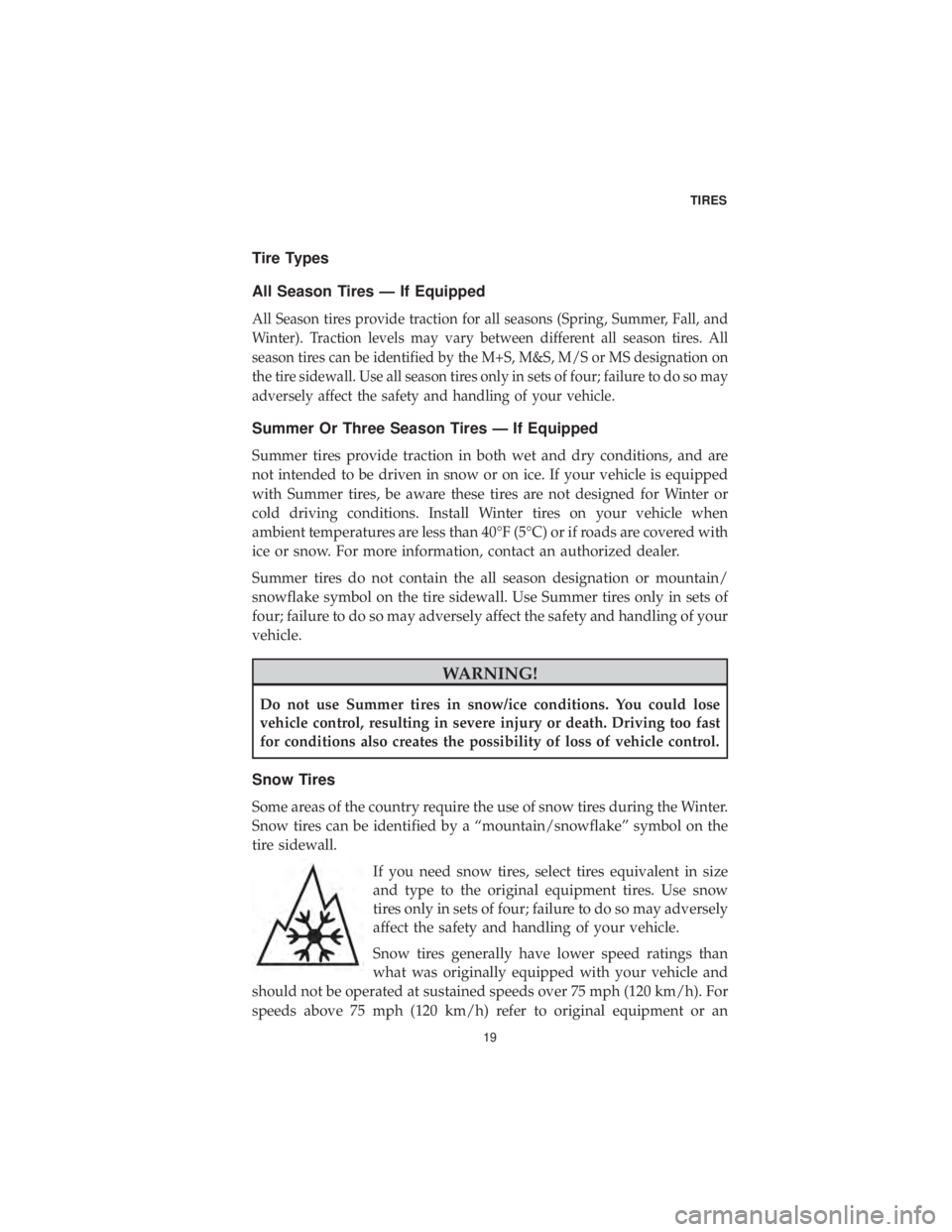
Tire Types
All Season Tires — If Equipped
All Season tires provide traction for all seasons (Spring, Summer, Fall, and
Winter). Traction levels may vary between different all season tires. All
season tires can be identified by the M+S, M&S, M/S or MS designation on
the tire sidewall. Use all season tires only in sets of four; failure to do so may
adversely affect the safety and handling of your vehicle.
Summer Or Three Season Tires — If Equipped
Summer tires provide traction in both wet and dry conditions, and are
not intended to be driven in snow or on ice. If your vehicle is equipped
with Summer tires, be aware these tires are not designed for Winter or
cold driving conditions. Install Winter tires on your vehicle when
ambient temperatures are less than 40°F (5°C) or if roads are covered with
ice or snow. For more information, contact an authorized dealer.
Summer tires do not contain the all season designation or mountain/
snowflake symbol on the tire sidewall. Use Summer tires only in sets of
four; failure to do so may adversely affect the safety and handling of your
vehicle.
WARNING!
Do not use Summer tires in snow/ice conditions. You could lose
vehicle control, resulting in severe injury or death. Driving too fast
for conditions also creates the possibility of loss of vehicle control.
Snow Tires
Some areas of the country require the use of snow tires during the Winter.
Snow tires can be identified by a “mountain/snowflake” symbol on the
tire sidewall.If you need snow tires, select tires equivalent in size
and type to the original equipment tires. Use snow
tires only in sets of four; failure to do so may adversely
affect the safety and handling of your vehicle.
Snow tires generally have lower speed ratings than
what was originally equipped with your vehicle and
should not be operated at sustained speeds over 75 mph (120 km/h). For
speeds above 75 mph (120 km/h) refer to original equipment or an
TIRES
19
Page 21 of 270
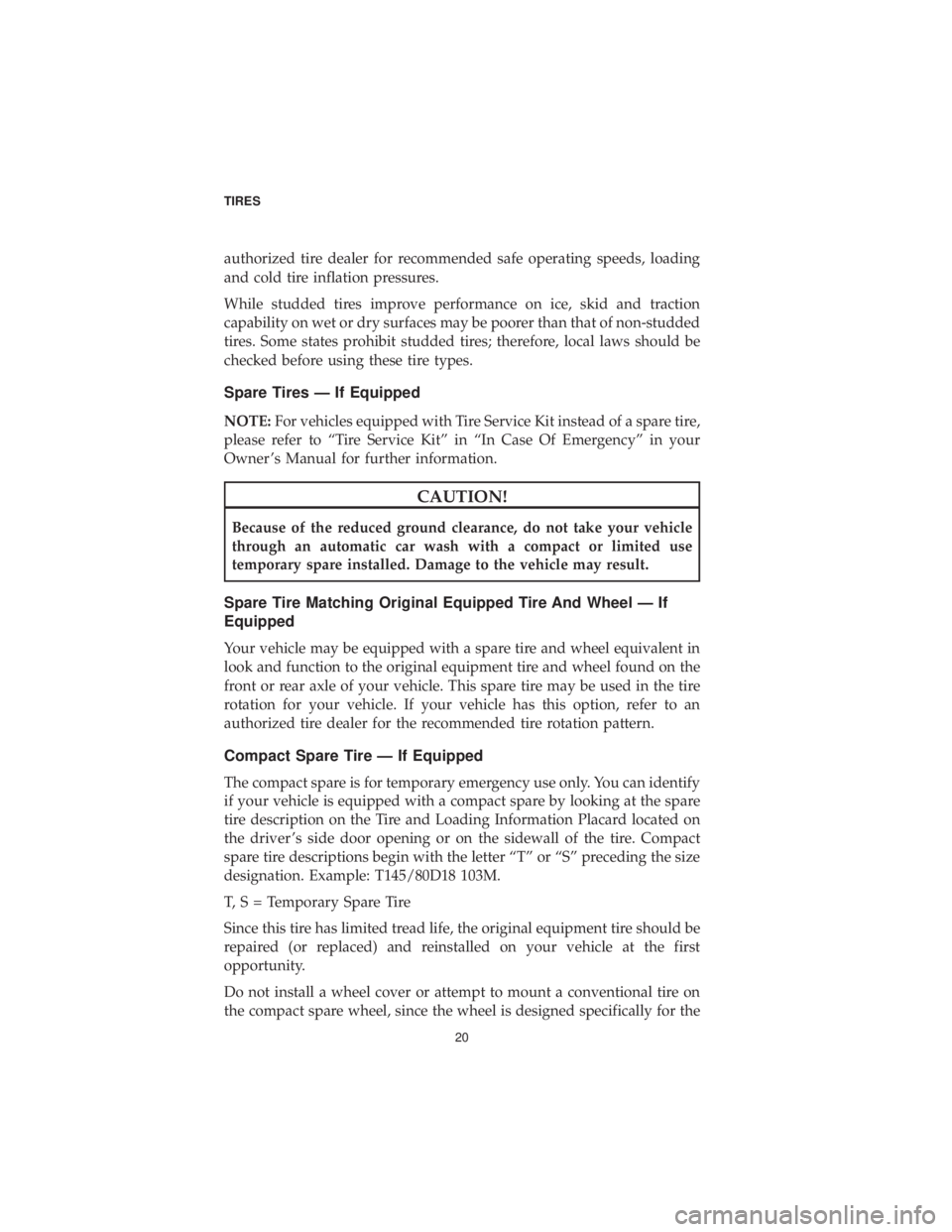
authorized tire dealer for recommended safe operating speeds, loading
and cold tire inflation pressures.
While studded tires improve performance on ice, skid and traction
capability on wet or dry surfaces may be poorer than that of non-studded
tires. Some states prohibit studded tires; therefore, local laws should be
checked before using these tire types.
Spare Tires — If Equipped
NOTE:For vehicles equipped with Tire Service Kit instead of a spare tire,
please refer to “Tire Service Kit” in “In Case Of Emergency” in your
Owner ’s Manual for further information.
CAUTION!
Because of the reduced ground clearance, do not take your vehicle
through an automatic car wash with a compact or limited use
temporary spare installed. Damage to the vehicle may result.
Spare Tire Matching Original Equipped Tire And Wheel — If
Equipped
Your vehicle may be equipped with a spare tire and wheel equivalent in
look and function to the original equipment tire and wheel found on the
front or rear axle of your vehicle. This spare tire may be used in the tire
rotation for your vehicle. If your vehicle has this option, refer to an
authorized tire dealer for the recommended tire rotation pattern.
Compact Spare Tire — If Equipped
The compact spare is for temporary emergency use only. You can identify
if your vehicle is equipped with a compact spare by looking at the spare
tire description on the Tire and Loading Information Placard located on
the driver ’s side door opening or on the sidewall of the tire. Compact
spare tire descriptions begin with the letter “T” or “S” preceding the size
designation. Example: T145/80D18 103M.
T, S = Temporary Spare Tire
Since this tire has limited tread life, the original equipment tire should be
repaired (or replaced) and reinstalled on your vehicle at the first
opportunity.
Do not install a wheel cover or attempt to mount a conventional tire on
the compact spare wheel, since the wheel is designed specifically for the
TIRES
20
Page 22 of 270
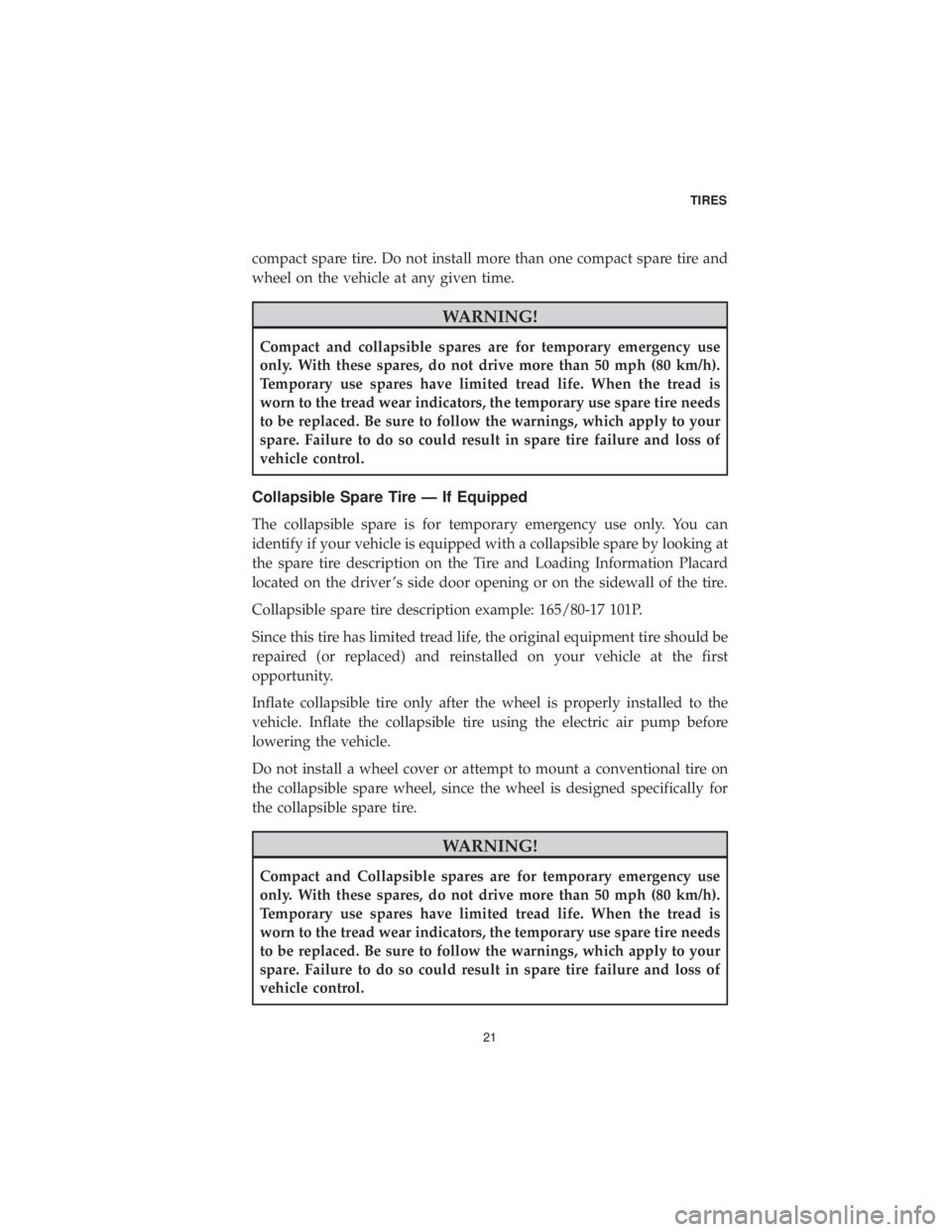
compact spare tire. Do not install more than one compact spare tire and
wheel on the vehicle at any given time.
WARNING!
Compact and collapsible spares are for temporary emergency use
only. With these spares, do not drive more than 50 mph (80 km/h).
Temporary use spares have limited tread life. When the tread is
worn to the tread wear indicators, the temporary use spare tire needs
to be replaced. Be sure to follow the warnings, which apply to your
spare. Failure to do so could result in spare tire failure and loss of
vehicle control.
Collapsible Spare Tire — If Equipped
The collapsible spare is for temporary emergency use only. You can
identify if your vehicle is equipped with a collapsible spare by looking at
the spare tire description on the Tire and Loading Information Placard
located on the driver ’s side door opening or on the sidewall of the tire.
Collapsible spare tire description example: 165/80-17 101P.
Since this tire has limited tread life, the original equipment tire should be
repaired (or replaced) and reinstalled on your vehicle at the first
opportunity.
Inflate collapsible tire only after the wheel is properly installed to the
vehicle. Inflate the collapsible tire using the electric air pump before
lowering the vehicle.
Do not install a wheel cover or attempt to mount a conventional tire on
the collapsible spare wheel, since the wheel is designed specifically for
the collapsible spare tire.
WARNING!
Compact and Collapsible spares are for temporary emergency use
only. With these spares, do not drive more than 50 mph (80 km/h).
Temporary use spares have limited tread life. When the tread is
worn to the tread wear indicators, the temporary use spare tire needs
to be replaced. Be sure to follow the warnings, which apply to your
spare. Failure to do so could result in spare tire failure and loss of
vehicle control.
TIRES
21
Page 23 of 270
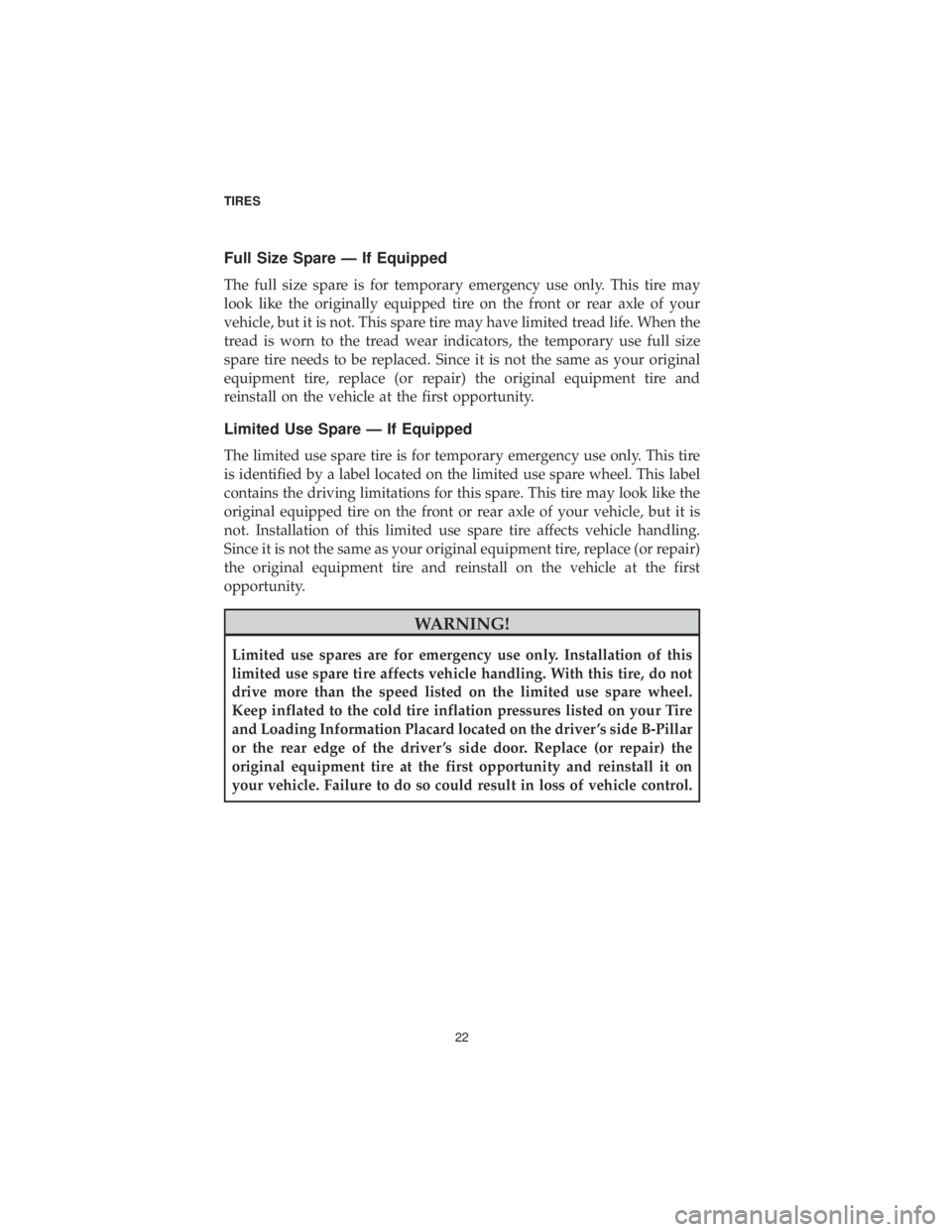
Full Size Spare — If Equipped
The full size spare is for temporary emergency use only. This tire may
look like the originally equipped tire on the front or rear axle of your
vehicle, but it is not. This spare tire may have limited tread life. When the
tread is worn to the tread wear indicators, the temporary use full size
spare tire needs to be replaced. Since it is not the same as your original
equipment tire, replace (or repair) the original equipment tire and
reinstall on the vehicle at the first opportunity.
Limited Use Spare — If Equipped
The limited use spare tire is for temporary emergency use only. This tire
is identified by a label located on the limited use spare wheel. This label
contains the driving limitations for this spare. This tire may look like the
original equipped tire on the front or rear axle of your vehicle, but it is
not. Installation of this limited use spare tire affects vehicle handling.
Since it is not the same as your original equipment tire, replace (or repair)
the original equipment tire and reinstall on the vehicle at the first
opportunity.
WARNING!
Limited use spares are for emergency use only. Installation of this
limited use spare tire affects vehicle handling. With this tire, do not
drive more than the speed listed on the limited use spare wheel.
Keep inflated to the cold tire inflation pressures listed on your Tire
and Loading Information Placard located on the driver ’s side B-Pillar
or the rear edge of the driver ’s side door. Replace (or repair) the
original equipment tire at the first opportunity and reinstall it on
your vehicle. Failure to do so could result in loss of vehicle control.
TIRES22
Page 24 of 270

DEPARTMENT OF TRANSPORTATION UNIFORM
TIRE QUALITY GRADES
The following tire grading categories were established by the Na-
tional Highway Traffic Safety Administration. The specific grade
rating assigned by the tire’s manufacturer in each category is shown
on the sidewall of the tires on your vehicle.
All passenger vehicle tires must conform to Federal safety require-
ments in addition to these grades.
Treadwear
The Treadwear grade is a comparative rating, based on the wear rate
of the tire when tested under controlled conditions on a specified
government test course. For example, a tire graded 150 would wear
one and one-half times as well on the government course as a tire
graded 100. The relative performance of tires depends upon the actual
conditions of their use, however, and may depart significantly from
the norm due to variations in driving habits, service practices, and
differences in road characteristics and climate.
Traction Grades
The Traction grades, from highest to lowest, are AA, A, B, and C.
These grades represent the tire’s ability to stop on wet pavement, as
measured under controlled conditions on specified government test
surfaces of asphalt and concrete. A tire marked C may have poor
traction performance.
WARNING!
The traction grade assigned to this tire is based on straight-ahead
braking traction tests, and does not include acceleration, corner-
ing, hydroplaning, or peak traction characteristics.
DEPARTMENT OF TRANSPORTATION UNIFORM TIRE QUALITY GRADES23
Page 25 of 270
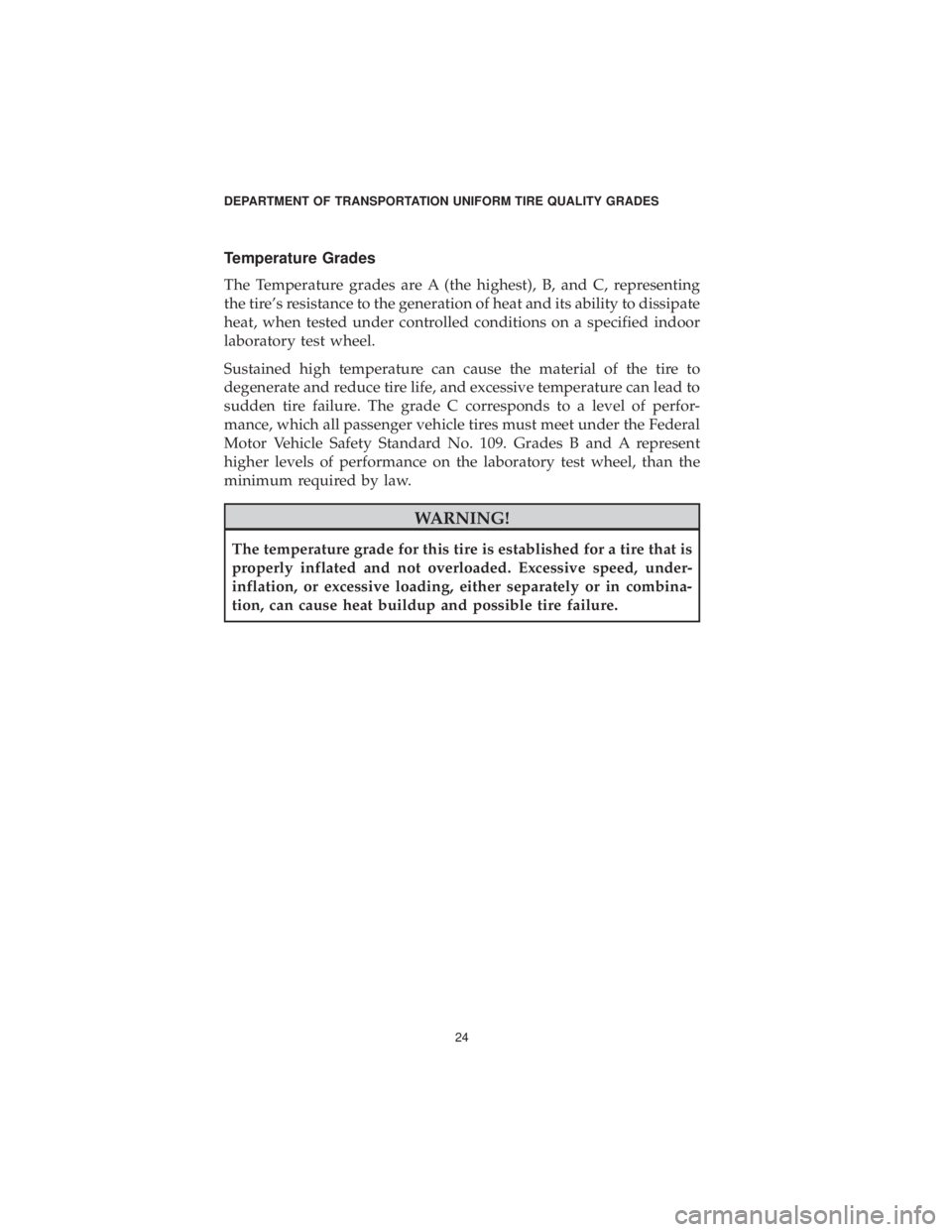
Temperature Grades
The Temperature grades are A (the highest), B, and C, representing
the tire’s resistance to the generation of heat and its ability to dissipate
heat, when tested under controlled conditions on a specified indoor
laboratory test wheel.
Sustained high temperature can cause the material of the tire to
degenerate and reduce tire life, and excessive temperature can lead to
sudden tire failure. The grade C corresponds to a level of perfor-
mance, which all passenger vehicle tires must meet under the Federal
Motor Vehicle Safety Standard No. 109. Grades B and A represent
higher levels of performance on the laboratory test wheel, than the
minimum required by law.
WARNING!
The temperature grade for this tire is established for a tire that is
properly inflated and not overloaded. Excessive speed, under-
inflation, or excessive loading, either separately or in combina-
tion, can cause heat buildup and possible tire failure.
DEPARTMENT OF TRANSPORTATION UNIFORM TIRE QUALITY GRADES24
Page 26 of 270
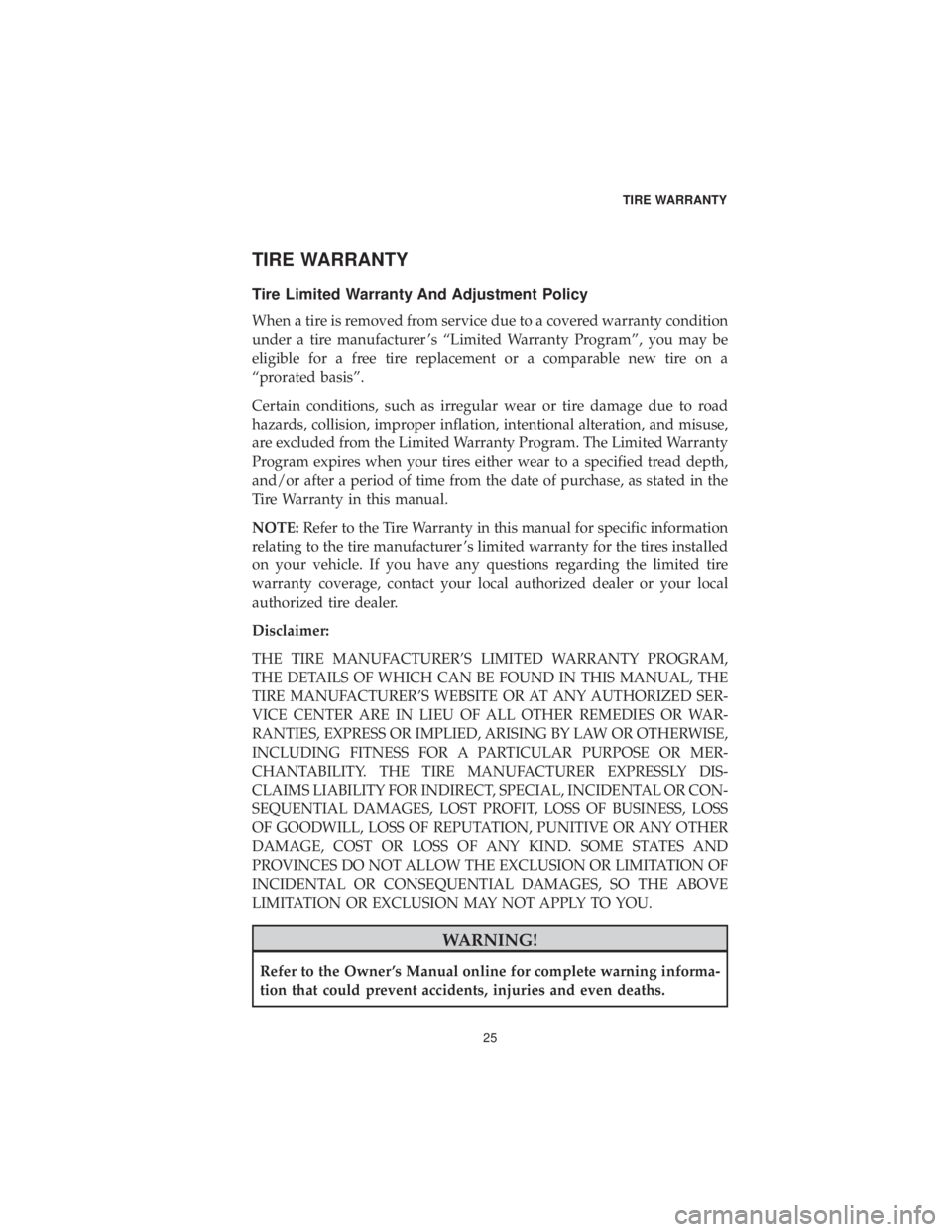
TIRE WARRANTY
Tire Limited Warranty And Adjustment Policy
When a tire is removed from service due to a covered warranty condition
under a tire manufacturer ’s “Limited Warranty Program”, you may be
eligible for a free tire replacement or a comparable new tire on a
“prorated basis”.
Certain conditions, such as irregular wear or tire damage due to road
hazards, collision, improper inflation, intentional alteration, and misuse,
are excluded from the Limited Warranty Program. The Limited Warranty
Program expires when your tires either wear to a specified tread depth,
and/or after a period of time from the date of purchase, as stated in the
Tire Warranty in this manual.
NOTE:Refer to the Tire Warranty in this manual for specific information
relating to the tire manufacturer ’s limited warranty for the tires installed
on your vehicle. If you have any questions regarding the limited tire
warranty coverage, contact your local authorized dealer or your local
authorized tire dealer.
Disclaimer:
THE TIRE MANUFACTURER’S LIMITED WARRANTY PROGRAM,
THE DETAILS OF WHICH CAN BE FOUND IN THIS MANUAL, THE
TIRE MANUFACTURER’S WEBSITE OR AT ANY AUTHORIZED SER-
VICE CENTER ARE IN LIEU OF ALL OTHER REMEDIES OR WAR-
RANTIES, EXPRESS OR IMPLIED, ARISING BY LAW OR OTHERWISE,
INCLUDING FITNESS FOR A PARTICULAR PURPOSE OR MER-
CHANTABILITY. THE TIRE MANUFACTURER EXPRESSLY DIS-
CLAIMS LIABILITY FOR INDIRECT, SPECIAL, INCIDENTAL OR CON-
SEQUENTIAL DAMAGES, LOST PROFIT, LOSS OF BUSINESS, LOSS
OF GOODWILL, LOSS OF REPUTATION, PUNITIVE OR ANY OTHER
DAMAGE, COST OR LOSS OF ANY KIND. SOME STATES AND
PROVINCES DO NOT ALLOW THE EXCLUSION OR LIMITATION OF
INCIDENTAL OR CONSEQUENTIAL DAMAGES, SO THE ABOVE
LIMITATION OR EXCLUSION MAY NOT APPLY TO YOU.
WARNING!
Refer to the Owner ’s Manual online for complete warning informa-
tion that could prevent accidents, injuries and even deaths.
TIRE WARRANTY
25
Page 27 of 270
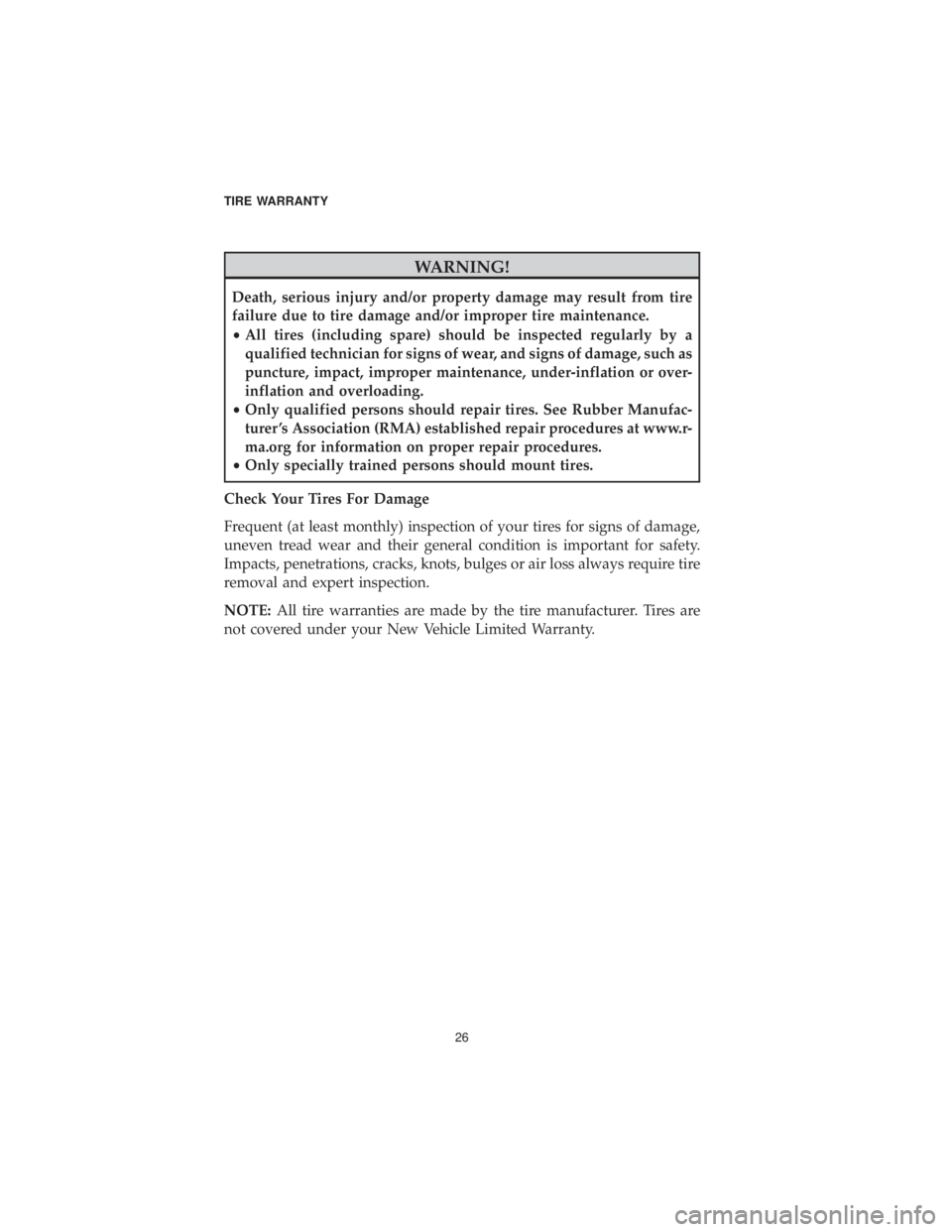
WARNING!
Death, serious injury and/or property damage may result from tire
failure due to tire damage and/or improper tire maintenance.
•All tires (including spare) should be inspected regularly by a
qualified technician for signs of wear, and signs of damage, such as
puncture, impact, improper maintenance, under-inflation or over-
inflation and overloading.
• Only qualified persons should repair tires. See Rubber Manufac-
turer ’s Association (RMA) established repair procedures at www.r-
ma.org for information on proper repair procedures.
• Only specially trained persons should mount tires.
Check Your Tires For Damage
Frequent (at least monthly) inspection of your tires for signs of damage,
uneven tread wear and their general condition is important for safety.
Impacts, penetrations, cracks, knots, bulges or air loss always require tire
removal and expert inspection.
NOTE: All tire warranties are made by the tire manufacturer. Tires are
not covered under your New Vehicle Limited Warranty.
TIRE WARRANTY
26